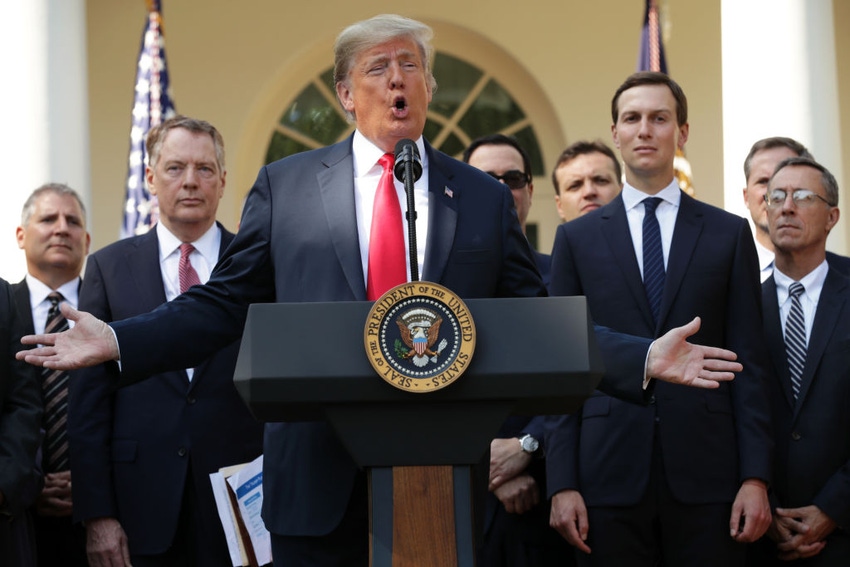NAFTA gets a new name, new life
Now called USMCA, the new NAFTA agreement with Canada is long on potential, short on details.
October 3, 2018

Not everyone we talk to out in the country is enamored with President Trump’s operating style at times. But none of them have argued with his results. His hardball trade negotiation approach certainly has roiled the waters and is yielding results.
Of course, agriculture’s plea to the President on NAFTA from Day 1 had been to “First, do no harm.” From an agricultural treaty standpoint, it appears like he has heeded that call.
Before Trump, had professional trade and diplomatic folks been polled about how long it would take to renegotiate the NAFTA agreement, very few if any would have guessed a little over a year. Trump’s approach and his tariffs or threats of tariffs threw the pros off and crunched their concepts of time like a bulldozer.
With a deadline of Sept. 30 in order to leave time for the current Mexican president to sign the final version, the U.S. and Canada announced they had come to agreement and the trilateral balance of the treaty would be preserved.
Now called the U.S., Mexico, Canada Agreement, or USMCA, North America has been re-NAFTAed, finally.
As it has seemed likely for weeks, the deal involved keeping the Chapter 19 and 20 sections involving dispute resolution intact and Canada yielding some access to its dairy market. Canada insisted it needed the international dispute panels to protect itself from over-aggressive U.S. use of tariffs and duties in certain cases.
Canadian officials claim the U.S. frequently imposes what it feels are improper tariffs on products from lumber to aircraft. Canada felt it especially needed that protection now, with Trump officials on the job.
The dairy deal allows U.S. access to 3.59% of the dairy market and an end to a milk ingredient pricing program that incentivized Canadian cheese processors to use surplus ingredients resulting from increased butter production. The program had kept American dairy producers out of the supply chain.
The market access figure is slightly better than the Trans-Pacific Partnership deal that was 3.25%. How they will “approximate” that carefully negotiated 3.59 percent wasn’t mentioned.
Officials were more close-mouthed about the steel and aluminum tariffs, whether they would be lifted or if some kind of quota system might be developed.
American pork producers are particularly concerned about those tariffs because the retaliatory tariffs have been aimed at them by Mexico, destination for roughly a third of their production. There was no mention of a timeline for resolving the steel and aluminum tariffs, just that there were intense negotiations taking place on the issue.
“We are not going to allow our steel industry to disappear,” President Trump said.
That sounds like a lean towards quotas rather than entirely dropping the tariffs.
Getting Mexico and the U.S. through the auto industry complexities was always the centerpiece of these negotiations. Auto manufacturing is a major part of the U.S. economy, and as such, was a major policy factor for President Trump.
While a parts and manufacturing model was already in existence, Trump wanted to tighten it. He was trying to make it more difficult for U.S. auto makers and parts manufacturers to justify moving plants and jobs to Mexico.
The final model requires 75% of an auto to be made in North America. The new wrinkle, to combat the lower Mexican wage standard, is that 40% of the auto must be made by workers earning at least $16 per hour, although the wages of designers and other personnel can be figured in.
Of course, whatever country one might be from, the threat of 25% tariffs on your autos hangs over your head. That threat is what brought the EU honchos over here with their hair on fire, extracting a delay while negotiating.
I imagine the German automakers were apoplectic. Both Mexico and Canada extracted some protection. Canada got a quota of 2.6 million cars, leaving lots of head room over their present number of 1.6 million. We haven’t seen a number for Mexico.
Part of the updating was a section establishing science-based standards for evaluating GMO seeds and synthetic chemical pesticides.
We fully expected the U.S. to eventually abandon the sunset clause demand, something that seemed out of place in a long-term partnership. But a strange compromise emerged, in which the treaty lasts for 16 years, unless renewed or renegotiated before then. The three will meet every six years to decide.
While there are good arguments for keeping currency manipulation issues separate from trade, this group doesn’t think so. The word is that this agreement has “enforceable” rules to keep countries from artificially weakening their exchange rates to get a trade advantage. Rather than something likely to be a factor among these countries, this is more likely a template for future agreements.
Now, the treaty is expected to be signed by the end of November and likely, be cussed and discussed by a new Congress in early 2019. Problem is, Congressmen are already making lists of peeves but that is irrelevant. Both the House and Senate have only two options: yes or no. No amendments are allowed.
Dittmer is a longtime beef industry commentator and executive vice president of the Agribusiness Freedom Foundation.
About the Author(s)
You May Also Like





